
William Clark (December 19, 1670 - July, 1742) was a merchant and town official in Boston, Massachusetts in the late 17th and early 18th centuries. Around 1713 he built a large house at North Square in Boston's North End.

William Clark (December 19, 1670 - July, 1742) was a merchant and town official in Boston, Massachusetts in the late 17th and early 18th centuries. Around 1713 he built a large house at North Square in Boston's North End.


Clark was born in Boston in 1670 to physician John Clark; siblings included future speaker of the House, John Clark. In 1702 he married Sarah Brondson; their children included Robert Clark and Benjamin Clark. [3]
William Clark "held several minor town offices, as constable in 1700; overseer of the poor in 1704; ... tithing-man in 1713, 1715 and 1718; ... selectman of Boston from 1719 to 1723, and representative to the General Court, 1719-22, 1724 and 1725." [4] He attended Old North Church (i.e. Second Church), and was a member of the Ancient and Honorable Artillery Company of Massachusetts. [5]
"His death in 1742 [was] attributed by some to the loss of forty sail of vessels in the French wars." Clark was buried "in his tomb at Copp's Hill, marked by a tablet bearing the family arms.". [6]

Samuel Turell Armstrong was a U.S. political figure. Born in 1784 in Dorchester, Massachusetts, he was a printer and bookseller in Boston, specializing in religious materials. Among his works were an early stereotype edition of Scott's Family Bible, which was very popular, and The Panoplist, a religious magazine devoted to missionary interests.

Major-General John Armstrong was a British military engineer and soldier, who served as Chief Royal Engineer and Surveyor-General of the Ordnance.

The Ancient and Honorable Artillery Company of Massachusetts is the oldest chartered military organization in North America and the third oldest chartered military organization in the world. A volunteer militia of the Commonwealth of Massachusetts, it is not part of the U.S. Armed Forces, but includes veterans and serving military members within its ranks.

King's Chapel Burying Ground is a historic graveyard on Tremont Street, near its intersection with School Street, in Boston, Massachusetts. Established in 1630, it is the oldest graveyard in the city and is a site on the Freedom Trail. Despite its name, the graveyard pre-dates the adjacent King's Chapel ; it is not affiliated with that or any other church.
John Richards was a colonial military officer, businessman, politician, and magistrate, best known for his participation in the Salem witch trials in 1692.

First Church in Boston is a Unitarian Universalist Church founded in 1630 by John Winthrop's original Puritan settlement in Boston, Massachusetts. The current building, located on 66 Marlborough Street in the Back Bay neighborhood, was designed by Paul Rudolph in a modernist style after a fire in 1968. It incorporates part of the earlier gothic revival building designed by William Robert Ware and Henry Van Brunt in 1867. The church has long been associated with Harvard University.
Thomas Brattle was an American merchant who served as treasurer of Harvard College and member of the Royal Society. He is known for his involvement in the Salem Witch Trials and the formation of the Brattle Street Church.
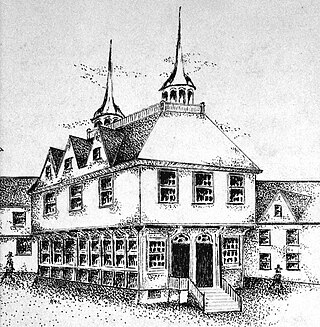
Robert Keayne was a prominent public figure in 17th-century Boston, Massachusetts. He co-founded the Ancient and Honorable Artillery Company of Massachusetts and served as speaker of the House of the Massachusetts General Court. Keayne was a prosperous London merchant who joined his fellow Puritans in Boston where he built a fortune. He was accused of unfair business practices, and brought before the legislature, the Massachusetts General Court. It found Keayne guilty, fined him, and compelled him to confess his "sins." He proclaimed his innocence, and justified his actions in elaborate detail in his will. It bequeathed £2500 to Boston, to upgrade the infrastructure with an aqueduct, relieve the city's poor, and fund the First Town-House, a grand public meeting place. He attached a condition to the effect that the bequest would become void if there were any legal actions against his estate; there were none.
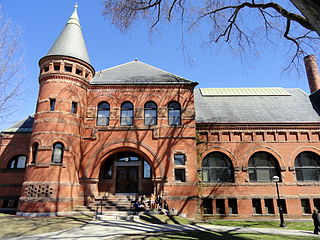
Samuel J.F. Thayer (1842–1893) was an American architect, notable for designing buildings such as the Providence City Hall and the Cathedral of St. George, as well as the town halls of Brookline, Stoughton, and Methuen, Massachusetts. He was part of the architecture firms, Martin & Thayer and Ropes & Thayer.
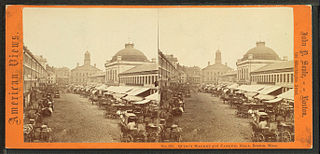
John Payson Soule (1828–1904) was a photographer and publisher in Boston, Massachusetts, and Seattle, Washington.
Henry H. Gilmore was a Massachusetts businessman and politician who served on the Board of Selectmen of the Town of Medford, Massachusetts, and as the Mayor of The City of Cambridge, Massachusetts.

Hartwell and Richardson was a Boston, Massachusetts architectural firm established in 1881, by Henry Walker Hartwell (1833–1919) and William Cummings Richardson (1854–1935). The firm contributed significantly to the current building stock and architecture of the greater Boston area. Many of its buildings are listed on the National Register of Historic Places.
Edward Hutchinson (1613–1675) was the oldest child of Massachusetts and Rhode Island magistrate William Hutchinson and his wife, the dissident minister Anne Hutchinson. He is noted for making peace with the authorities following his mother's banishment from the Massachusetts Bay Colony during the Antinomian Controversy, returning to Boston, and ultimately dying in the service of the colony that had treated his family so harshly.
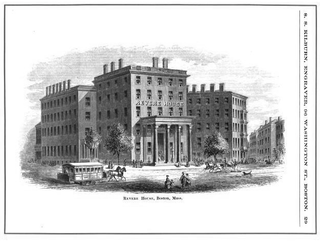
William Washburn (1808–1890) was an architect and city councilor in Boston, Massachusetts, United States, in the mid-19th century. He designed Boston's National Theatre (1836), Revere House hotel (1847), Tremont Temple (1853) and Parker House hotel (1854). He served on the Boston Common Council from ward 6 in 1854 and 1855. He was chairman of the Boston Board of Aldermen in 1855.

Grace Church (1835–1865) was an Episcopal church in Boston, Massachusetts, located in Beacon Hill, on Temple Street. The church operated for 30 years. Ministers included Thomas M. Clark (1836–1843); Clement Moore Butler (1844–1847); and Charles Mason.
Addington Davenport was a Massachusetts Superior Court of Judicature justice from 1715 to 1736.
Elijah Crane was a Canton, Massachusetts farmer, and inn keeper, who served as the first Town Clerk, and on the first Board of Selectmen of Canton, Massachusetts. Crane was also the first representative to the Massachusetts House of Representatives from Canton, and the sheriff of Norfolk County, Massachusetts from May 16, 1810 to 1811 and from June 20, 1812 to 1834.

Sir Charles Hobby (1665–1715) was a Boston merchant and militia colonel, commanding a provincial regiment during the siege of Port Royal 1710, and serving as its acting governor in 1711. He was knighted in 1705.
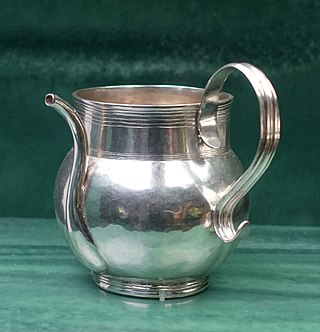
Samuel Haugh was an early American silversmith, active in Boston. Only three of his works are known to survive: two cups and a spoon.

William Homes Jr. , sometimes spelled William Holmes Jr. , was an American silversmith, active in Boston. He was the son of William Homes.